I've seen a few posts, mostly from Facebook contacts saying something like "this year we are donating to charitiy instead of sending Christmas cards."
Well done.
But I really don't see the point. If you feel that you should be giving to charity, and have some spare money, then do so. If not, then don't.
But please don't tell me that you've decided to give the £20 you would have spent on cards and stamps to charity instead, because that just doesn't make any sense.
Not that I'm disappointed to not get a card - Facebook, Linkedin et al have largely blunted the point of sending Christmas cards to those people whom I only ever said hi to at Christmas - I can randomly say hi to them anytime I like now, and I don't have to buy a stamp, or try to remember where they live.
And that's a good thing, as quite a large proportion of my friends have moved abroad. These are exactly the people that I would normally want to send cards to, but wont, partly because I'm not organized enough to buy and send the cards in enough time for them to arrive by Christmas, and partly because I'm too tight to spend all that money on postage.
So, if you didn't get a card from me this year its not because I gave the money to charity instead, its simply that you're not on my Chritmas cards list. I would like to now formally wish you a Happy Christmas and all the best for 2011.
Oh, and one last thing - if you sent me a card this year but didn't get one in return, then this is simply an oversight on my part, or a problem with the postal system - you WILL be on the Christmas card list next year.
Either that, or I just don't like you.
Sorry for the misleading name but you will find some posts that are specifically about walking in London. The rest is the other stuff I get up to.
Friday, 24 December 2010
Tuesday, 16 November 2010
A Trip to the V&A
So, its time for another Walking in London post.
We've visited the Victoria and Albert Museum a couple of times recently, and I used our second visit to experiment with some shallow depth of field shots.
I can recommend a visit to the Renaissance exhibition - there are some truely spectacular things on show. The selection I give you here are are slightly random...
This is a detail of iron railings, just to get my eye in with the DOF.
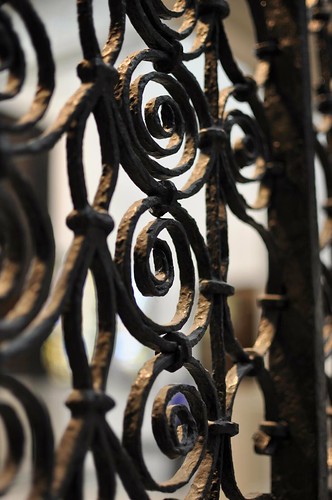
A Statue with a rather friendly looking dragon.
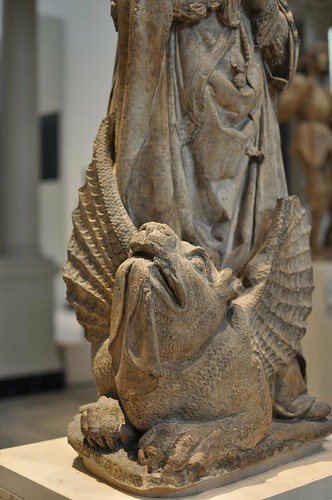
This statue is made of wood - lime, according to the V and A's website. Its St. George, originally was part of an altarpiece. Here he's shown after defeating the Dragon which hangs limply from his rather delicate hand.
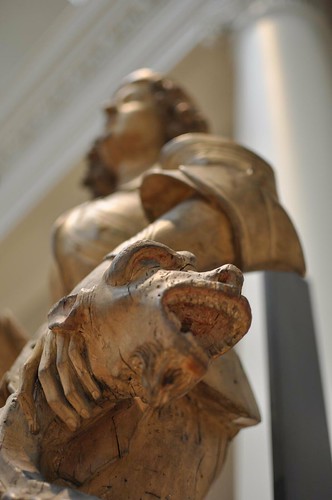
And here he is again, shown in a relief from Genoa. This one seems an altogether more scary vision of a dragon, and unusually, is almost the same size as the Saint.

A detail of a Knights spurs from a memorial
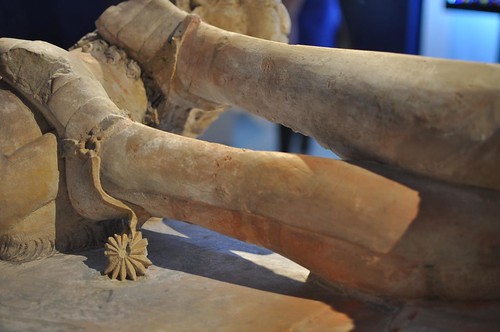
Another alterpiece, this one showing scenes from Revelation.
I'm guessing this isn't a church that I'd enjoy a sermon from...
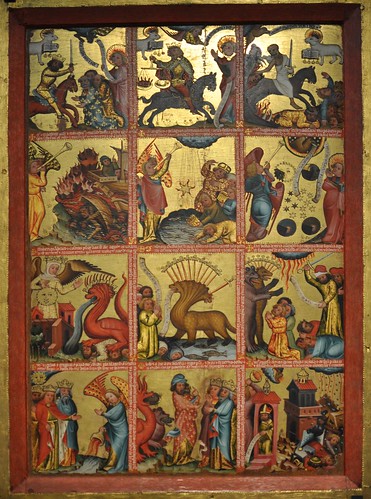
And this is the facade of a house, built around 1600 for London merchant Sir Paul Pindar. The house was built on Bishopsgate, outside the city. Like many London houses, it was deeper than it was wide, with stables and a garden extending behind. The house was pulled down in 1890 to make room for the enlargement of Liverpool Street station. There's an old photo of the house before demolition here: http://spitalfieldslife.com/2010/11/05/a-room-to-let-in-old-aldgate/

And this little gem was for me the most surprising of all - it's one of Leonardo Da vinci's notebooks.
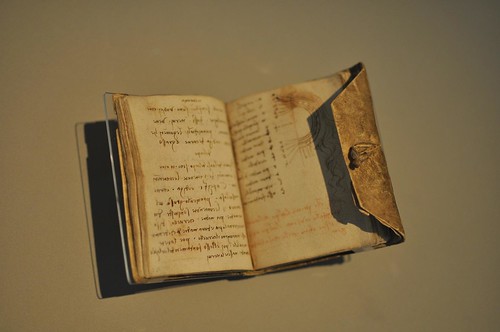
But of course for us, this is the most important part of any visit:
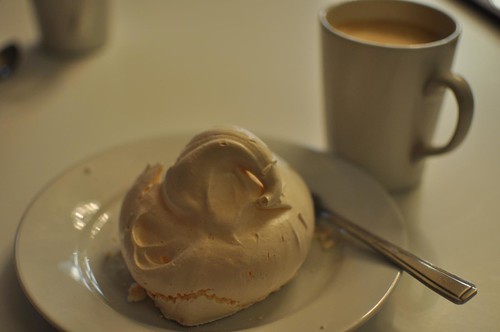
We've visited the Victoria and Albert Museum a couple of times recently, and I used our second visit to experiment with some shallow depth of field shots.
I can recommend a visit to the Renaissance exhibition - there are some truely spectacular things on show. The selection I give you here are are slightly random...
This is a detail of iron railings, just to get my eye in with the DOF.

A Statue with a rather friendly looking dragon.

This statue is made of wood - lime, according to the V and A's website. Its St. George, originally was part of an altarpiece. Here he's shown after defeating the Dragon which hangs limply from his rather delicate hand.

And here he is again, shown in a relief from Genoa. This one seems an altogether more scary vision of a dragon, and unusually, is almost the same size as the Saint.

A detail of a Knights spurs from a memorial

Another alterpiece, this one showing scenes from Revelation.
I'm guessing this isn't a church that I'd enjoy a sermon from...

And this is the facade of a house, built around 1600 for London merchant Sir Paul Pindar. The house was built on Bishopsgate, outside the city. Like many London houses, it was deeper than it was wide, with stables and a garden extending behind. The house was pulled down in 1890 to make room for the enlargement of Liverpool Street station. There's an old photo of the house before demolition here: http://spitalfieldslife.com/2010/11/05/a-room-to-let-in-old-aldgate/

And this little gem was for me the most surprising of all - it's one of Leonardo Da vinci's notebooks.

But of course for us, this is the most important part of any visit:

Thursday, 4 November 2010
On Order
I have ordered this, a few minutes ago:
I would post a picture here of what its going to look like but my choice of paint colour has been discountinued, and there are no pictures of the replacement Black Oak Brown yet.
I have found this though - on the German VW website on the Configurator.

Is this an acceptable colour for a Scirocco?
This will be my first new car purchase. The very long and painful wait starts here...
edit:
Actually on Order now....
I'm not waiting any longer - my Scirocco is actually on order now, in Reflex Silver. Should look a bit like this...

Update 06/01/11:
Incredibly, my dealer (Colbornes of Guildford) still can't give me a build week for my car. Not even a guess. This is not good news as I have no idea when the car will actually be made.
Update 17/01/11:
Call from the dealer a minute ago (well, a call back from a message I left) and my car is still unconfirmed. For the first time he had mentioned a build week - 8, and from what I've read elsewhere I should get the car 3 weeks after the quoted build week. But obviously I can't start counting weeks until its confirmed. I think I'll start a new blog specifically about the Scirocco, my impressions of buying it, and then later, owning it.
New blog specifically about the Scirocco: http://silverscirocco.blogspot.com/
Volkswagen Scirocco GT 2.0 TSI 210PS 6Spd manual
With:
Sumatra Metallic Paint
Black Merlin Cloth Upholstery
Rear Parking Sensor
Panoramic Sunroof (tilt only)
Electric Folding Door Mirrors
DAB digital radio receiver
I would post a picture here of what its going to look like but my choice of paint colour has been discountinued, and there are no pictures of the replacement Black Oak Brown yet.
I have found this though - on the German VW website on the Configurator.

Is this an acceptable colour for a Scirocco?
This will be my first new car purchase. The very long and painful wait starts here...
edit:
Actually on Order now....
I'm not waiting any longer - my Scirocco is actually on order now, in Reflex Silver. Should look a bit like this...

Update 06/01/11:
Incredibly, my dealer (Colbornes of Guildford) still can't give me a build week for my car. Not even a guess. This is not good news as I have no idea when the car will actually be made.
Update 17/01/11:
Call from the dealer a minute ago (well, a call back from a message I left) and my car is still unconfirmed. For the first time he had mentioned a build week - 8, and from what I've read elsewhere I should get the car 3 weeks after the quoted build week. But obviously I can't start counting weeks until its confirmed. I think I'll start a new blog specifically about the Scirocco, my impressions of buying it, and then later, owning it.
New blog specifically about the Scirocco: http://silverscirocco.blogspot.com/
Labels:
Black Oak Brown,
Car,
German,
Konfigurator,
Reflex Silver,
Scirocco,
Sumatra,
Volkswagen,
VW
Monday, 1 November 2010
Scotney Castle
We braved the rain on Saturday to take a look at Scotney Castle in Kent. We've been a few times before, but this is the first time since the new house was properly opened. I can also happily report that the tea room is now up to National Trust standard.
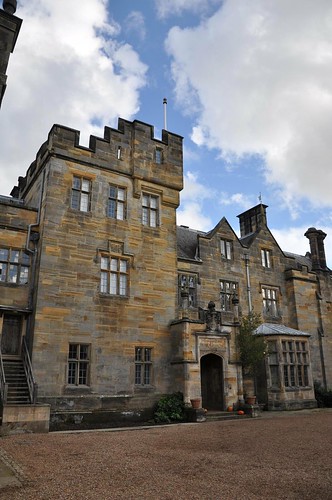
The new house was build in the late 1830s
The interior is very interesting - much less polished and tidy that the average National Trust property, and it really felt more like looking around someone's house that normal.
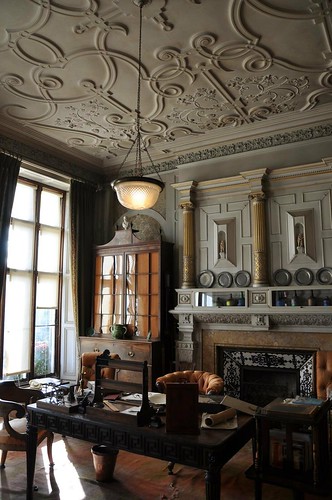
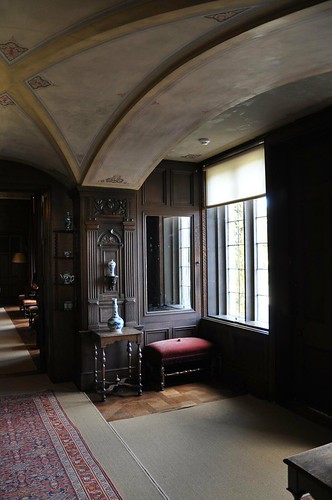

With the weather being a bit changeable, I think some of outdoor photos worked really well.
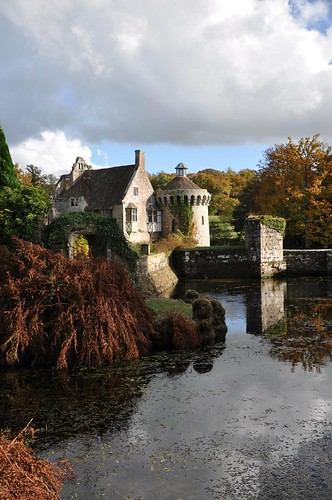



My attempt at being arty with a set of glasses in the new house.


The new house was build in the late 1830s
The interior is very interesting - much less polished and tidy that the average National Trust property, and it really felt more like looking around someone's house that normal.



With the weather being a bit changeable, I think some of outdoor photos worked really well.




My attempt at being arty with a set of glasses in the new house.

Thursday, 21 October 2010
2,517,407 Steps
Quick update on the steps front - I am currently on 2,517,407. That's a little over 1,250 miles since January 1st and well on target for my planned 1,500 miles for the year. That is as long as we don't get torrential rain for the rest of the year.
I'm still not sure how I'm going to manage 2,011 miles in 2011 - I'm guessing I'll have to keep up the 7500-8500 step average and then go for some massive walks to top it up. I'll be interested to see how that works out.
In other news:
In the 12 months since 14th October 2009 to 14th October 2010 I've managed to go from 196lb to 178lb, increasing both water intake, and fruit and veg and I've smoked nothing in that period as well.
So well done me.
The target for the next 15 months is to loose some more weight. I'm feeling much better than I did at 14 stone, but at over 12 and half stone I'm still on the heavy side. According to the BMI calculators I should be between 10 and 11 stone, but I think that's probably optimistic. So target weight is 160lbs.
If that goes well then the only thing left would be to get the alcohol intake down. My average units per week are probably between 3 and 4 as they should be, but too much of that tends to be in one sitting. Anyway - no plans to change that until 2012!
I'm still not sure how I'm going to manage 2,011 miles in 2011 - I'm guessing I'll have to keep up the 7500-8500 step average and then go for some massive walks to top it up. I'll be interested to see how that works out.
In other news:
In the 12 months since 14th October 2009 to 14th October 2010 I've managed to go from 196lb to 178lb, increasing both water intake, and fruit and veg and I've smoked nothing in that period as well.
So well done me.
The target for the next 15 months is to loose some more weight. I'm feeling much better than I did at 14 stone, but at over 12 and half stone I'm still on the heavy side. According to the BMI calculators I should be between 10 and 11 stone, but I think that's probably optimistic. So target weight is 160lbs.
If that goes well then the only thing left would be to get the alcohol intake down. My average units per week are probably between 3 and 4 as they should be, but too much of that tends to be in one sitting. Anyway - no plans to change that until 2012!
Friday, 15 October 2010
Happy Birthday to me.
Yep its my birthday today, which I'm spending at my desk at work. Not too exciting, but this evening, we are going for dinner to Smiths of Smithfield.
Looks like it should be excellent.
Looks like it should be excellent.
Monday, 4 October 2010
Home and Dry
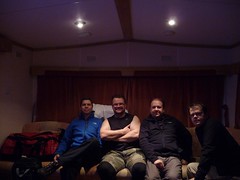
Back at work now after a fantastic weekend with the boys.
Thursday we took the Jaguar up to Blackpool, which was grim (well it is up north)
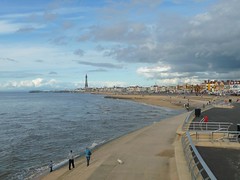
and after a very short stop went on to the Langdale Valley and found the Caravan, and shortly after, the pub.
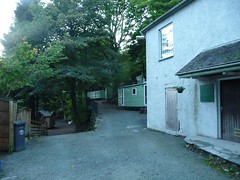
Friday Morning we set out early, leaving the caravan looking like this,

and headed up into the mist...
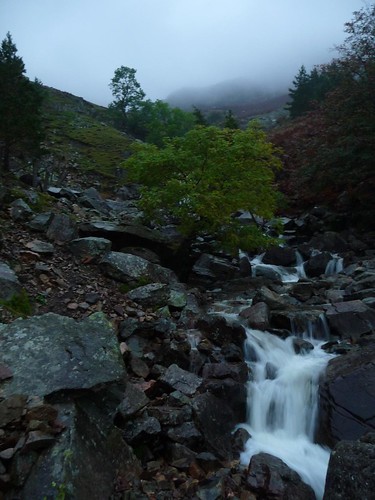
But it was just too wet to get very far.
After breakfast we headed to Keswick, for coffee and cake, and a look arounf Cars of the Stars - a very strange little museum with some very interesting exibits like these.
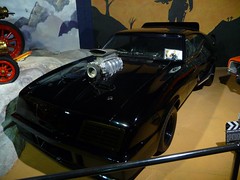
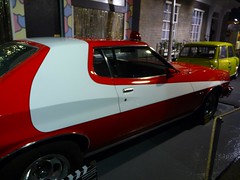
We stopped at Aria Force on the way back.
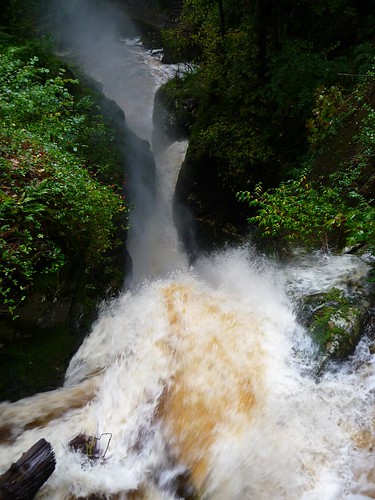
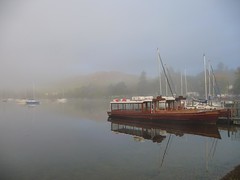
Labels:
Aria Force,
Cars of the Stars,
Jaguar,
Keswick,
Lakes,
Langdale
Wednesday, 29 September 2010
Walking London's Roman Wall.
The City of London, or the Square Mile, is basically the bit of town that was originally inside the walls that the Romans built. Its a little larger now, but not much. At first glance it would be easy to think that there's not much of those walls remaining, but a little investigation turns up an amazing amount, from street names like London Wall, Houndsditch, Barbican, Aldgate, Bishopsgate, Moorgate, Newgate, Ludgate and more, and huge surviving sections of wall at Tower hill and the Barbican.
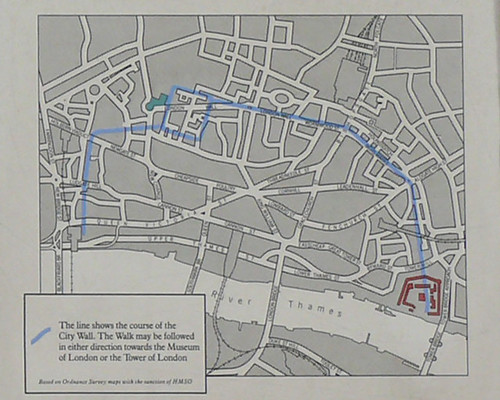
The Museum of London planned a Wall walk in the 1980's, but as the intention was to guide tourists to the museum itself, this only went from the Tower of London to the museum building - about half the length of the Wall (if you include the riverside section). This was marked with 21 numbered blue and white tile information panels - plus an introduction at each end of the walk; about half of which still exist. Some are in remarkably good condition, some have been replaced, others are just missing. The fate of some echo the recent history of london - for example panel 8 was destroyed by an IRA bomb.
So this post is a description of a walk around the entire route of the walls, with some Roman themed detours, and a few of my pictures. We start and end at The Tower of London - allow at least 2 and a half hours without the detours.
1. From Tower Hill tube, take the steps down under the underpass. The interesting remains here are not Roman, but are of a medieval pedestrian gateway through the Wall - a postern. The information panel is on the wall, but this is not Panel 1, that is no longer here - I suspect the modern steel panels on the handrail around the excavations have replaced the original tile one.
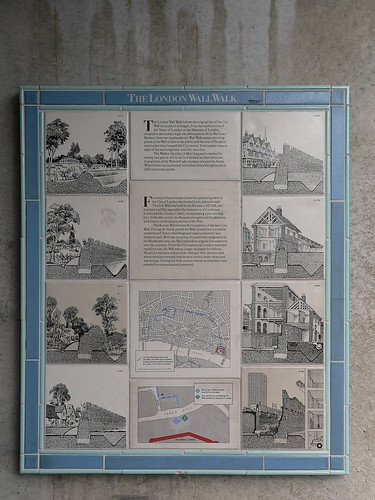
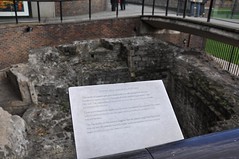
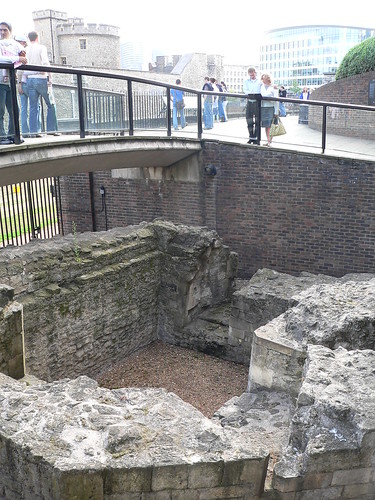
2. Go back though the underpass, turn right halfway up the steps. The wall remains here are some of the largest remaining, and the Roman section can be seen - obvious because of the red tile sections. Panel 2 is on the modern wall to the left. The statue here is said to be of the emperor Trajan.
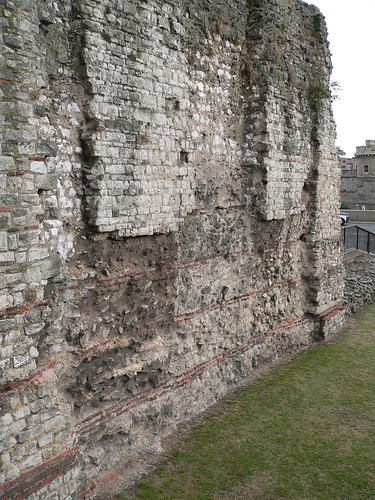
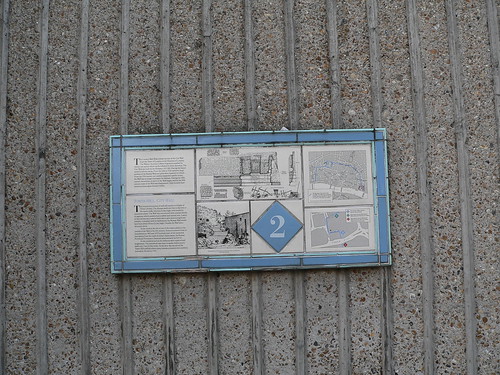
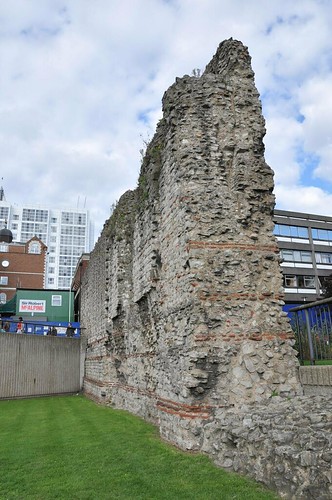
3. Go back to the tube station, turn left and follow the road. Look at the brass plaque on the hotel front, which has some interesting information about the Wall.
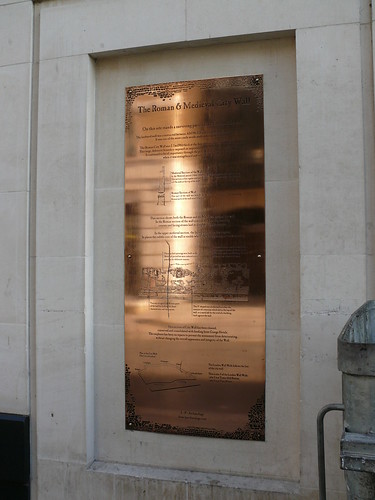
3a. Go through the hotel driveway to the large section of visible wall. This is the original location of Panel 3, which has been replaced by this Brass one. Follow the walkway here that goes through a hole in the wall, then through the courtyard to the road beyond. Turn left, under the railway arch and walk through America Square.
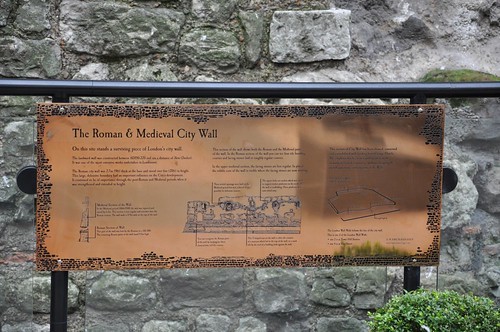
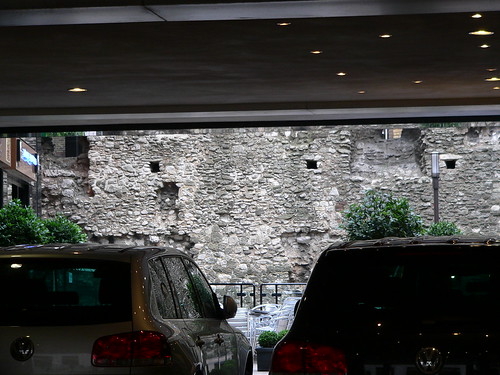
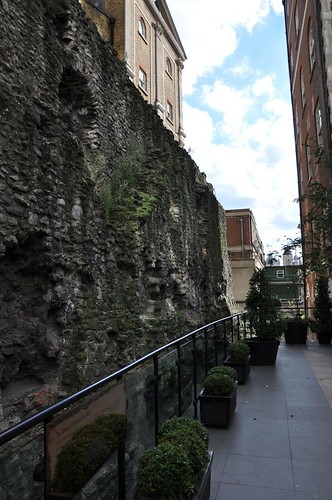
3b. Number One America Square now has a conference centre in its basement, which has a large section of preserved wall running right through it as a feature. I haven't been in personally, but their website shows some nice views of the wall remains. At the other side of this building, look over the low wall, where a portion of wall in the basement is visible through glass panels. You can use the parish boundary marker on the building opposite as a rough guide to where the wall ran.

4. Return to Vine street, and continue north. The original wall walk map shows panel number 4 to be in the next courtyard on the left hand side of the road. Either the panel has gone, or the area its in is no longer open to the public. From here turn take the next left, then right towards Aldgate.
There is other evidence of the wall here, notice the building names such as Roman Wall House.
5. At the large intersection that is now Aldgate, you will find panel 5 on the low wall to the Sir John Cass' school playground.
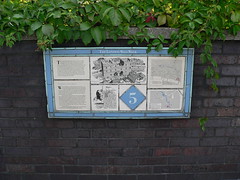
5a. I'm not sure how long this will be here, but just at the moment there is an artwork here, that is apparently a representation of the rooms over the Gateway of the Aldgate.
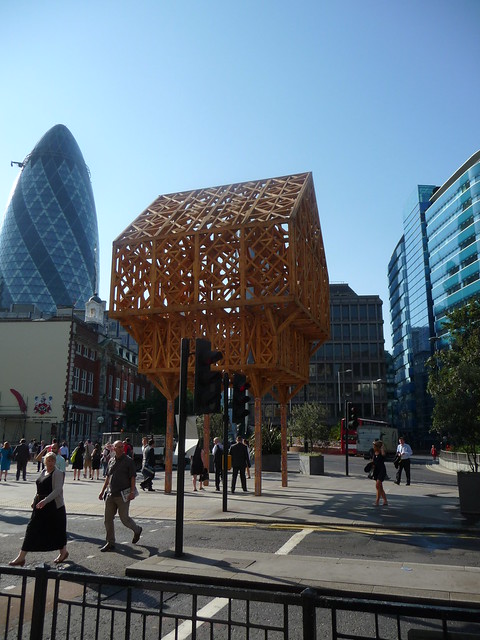
6. Go down into the subway entrance to the right. There are some interesting tiled information planels in the subway, including Panel number 6. Where the subway excavations crossed the line of the wall are now some large tile cutaways of the wall - but at the time of writing, this subway is closed to the public, which is a shame, as I found plaque 6 to be particularly well preserved. Head back up to ground level, and follow Duke's Place and then Bevis Marks towards the City.
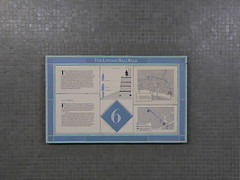
7. Bevis Marks would have been the route of the road inside the city walls, with the parallel Houndsditch literally being the ditch outside the city walls. You will find Panel 7 halfway along Bevis Marks, on the left hand side, under a collonade, right next to the entrance of the London Synagogue.
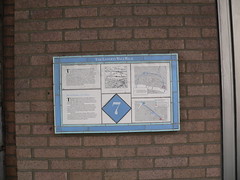
8. Follow Bevis Marks until it becomes Camomile Street and then emerges onto the large junction with Bishopsgate and Wormwood Street. Plaque 8 was at this junction but was destroyed by an IRA Bomb in 1993. The actual site of the Bishops Gate here was marked on both sides of the street by stone bishops mitres set into the walls of the buildings. The one in the picture below has now gone - as this building has been replaced by the Heron Tower. I'll be interested to see if this new building gets any sign once its complete. (At the time of writing, the one facing it is still there).
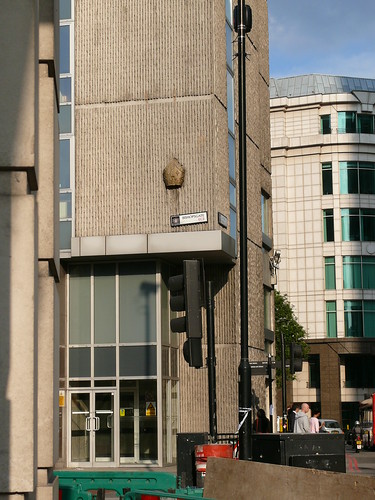

9. Turn right into Bishopsgate, and then immediatly left into the path though the churchyard. The backs of the buildings on the left are all quite modern, but still follow the line of the wall. Panel 9 was here somewhere, but I've not yet been able to find any trace of it. In most places where Panels are missing, there is usually still a bracket or post. In places like this, where there is nothing I can't be sure I'm looking in exactly the right place...

10. At the end of the path, turn left and then right onto the road called London Wall. After a short distance you will come to All Hallows on the Wall, whose north edge is built exactly on the london wall. There is a chapel here that follows the line of an original roman tower on the wall - just visible in the second picture below. I have yet to see this for myself, as I have never seen the church open. The wall is prominent here in the churchyard, but Panel 10 has gone. I suspect that the 2 iron poles with the angled tops visible in the first picture originally held it.
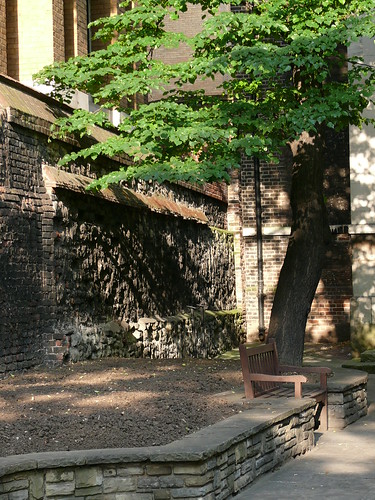
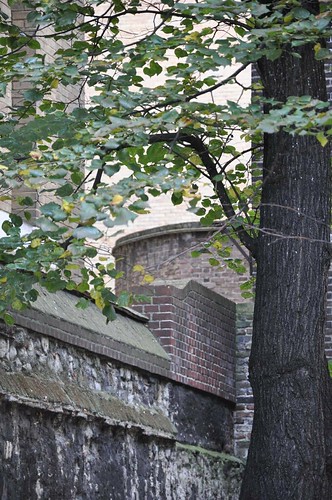
10a Walk along London Wall towards Moorgate. After you've passed the entrance to Finsbury Circus, note that the area to the right was the site of the second St Mary of Bethlehem Hospital or Bedlam, as it became know. The institution was not here for very long (only 150 years), as the building suffered from subsidence - hardly surprising as it was built on the ditch outside the city wall.
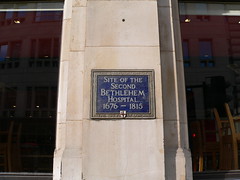
11. Panel 11 can be found on the north east corner of London Wall and Moorgate. The Moor Gate itself was not an original Roman gate in the wall - they had no need of one here as the land outside the wall was marsh. In Medeival times the marsh was drained (and filled with bones from St Peters charnel house) and this gate was added.

11a. Stay on the north side of London wall here, and get up onto the Barbican highwalks. London Wall the road here diverges from the line of the wall itself. the remains of St Alphages church can be seen here, but note that the remianing part of the church is some distance from the wall.
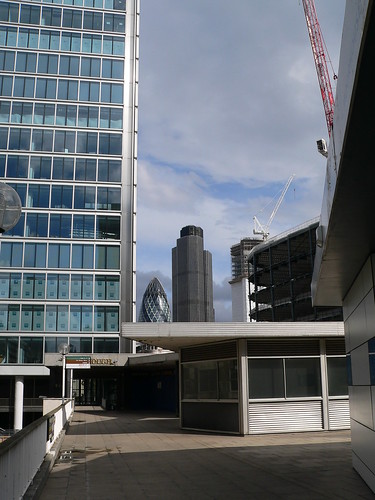
12. There are large sections of wall visible in St Alphages gardens, and this is now the north wall of the Roman fort that was constructed before the walls. There are three seperate gardens here - on the North side the Salters Hall have very smart gardens.

12a. On the South side is a long and narrow public garden with this old Plaque on the wall.
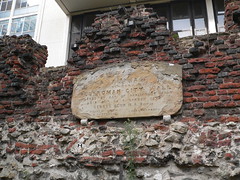
12b. At the Western end of this is another public garden, much like the Salters one, and here, between two planters is the remains of two stumps, which I assume are the original location for Panel 12.

13. Panel 13 is just a little to the west of the gardens on the side of Roman House, and marks the location of the Cripple Gate.
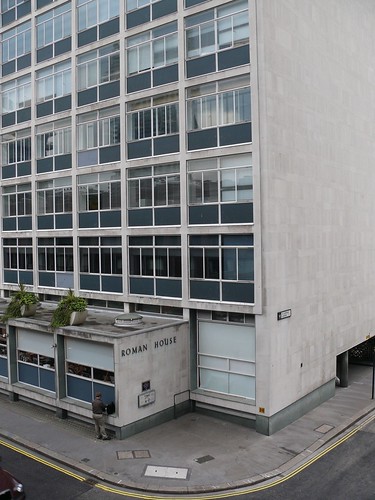

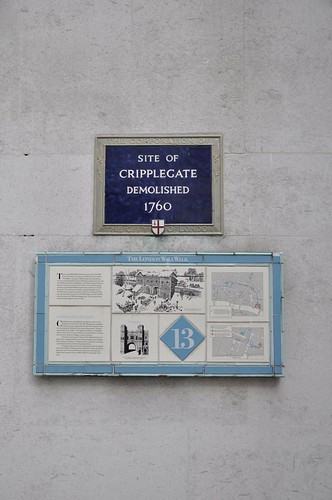
14. From here, walk into the Barbican compex at ground level, around St Giles Cripplegate church. There are many remains of the wall here, including the bases of some of the towers. Panel 14 is on the handrail in the churchyard.
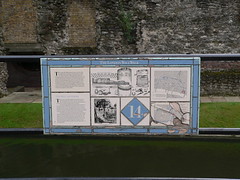
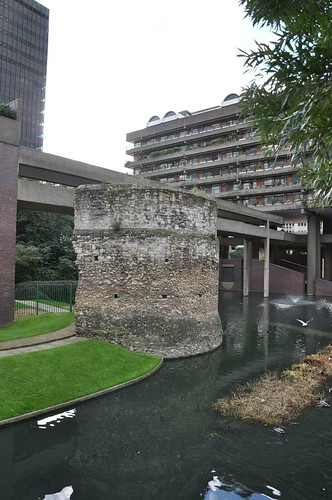
15. Finding Panel 15 takes a little effort. Retrace your steps to the site of Cripplegate, then continue along Wood Street to junction of London Wall. Turn right and follow London Wall until you reach the entrance to the underground car park. Go into the Museum gardens here and follow the line of the wall as far as you can into the Barbican. Panel 15 is on your right.
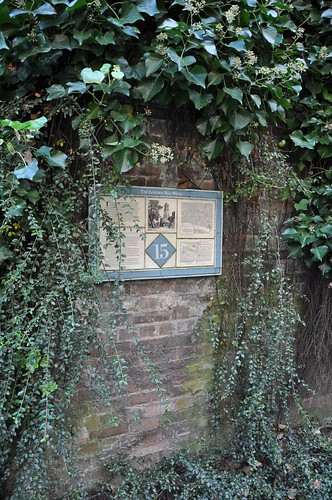

16. Retrace your steps again along the route of remains. The Barber Surgeons (whose modern hall is here) used to have their hall right against the wall - and even used one of the towers as a court. This Tower has now been turned into a small herb garden - and as far as I can work out, this was the location of panel 16.
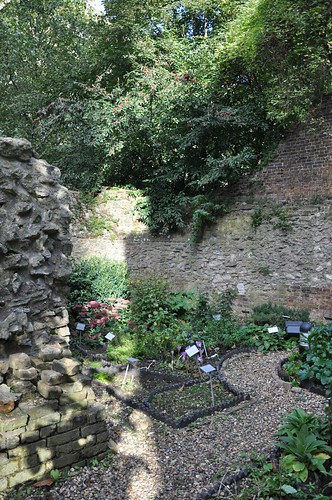
Its interesting to note that the shape of the new hall echos the Wall tower.
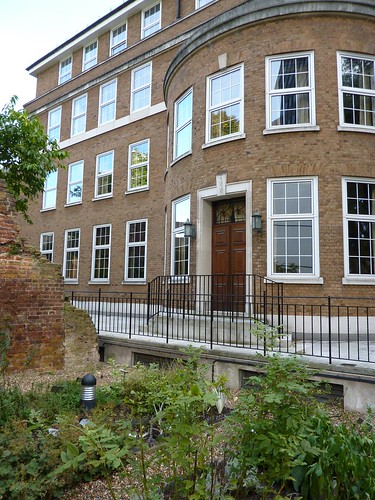
17. Panel 17 is also missing, but would originally have been on the other side of the remains in the picture below. The white building in the picture is the Museum of London, and a window looks down on the wall remains from the Roman Gallery.
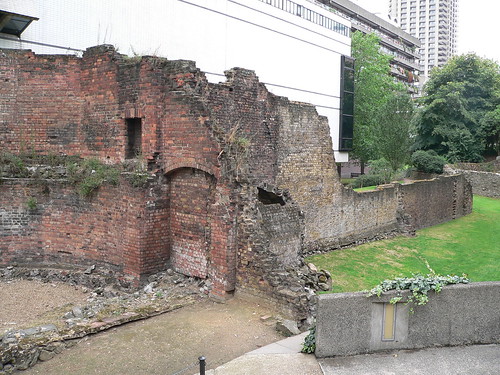
18. Panel 18 survives at the bottom of the ramp next to the entrance to the car park.
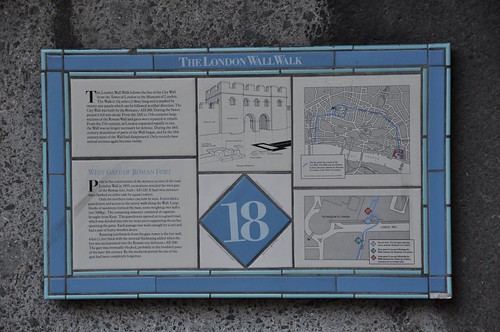
18a. There are remains of a gate under the road behind a door marked private that can be seen on tours run by the museum. Look out on the meseum website for Tours of the Roman Fort. I got on one in August and found it very interesting.
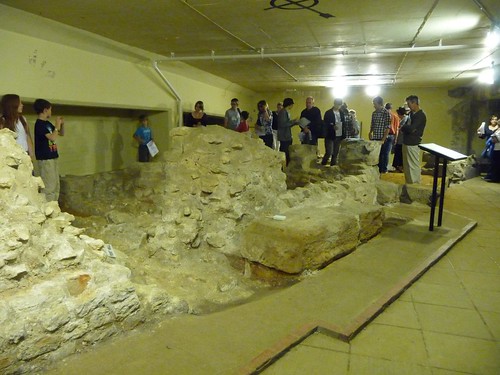

18a Detour. This is the best place to detour into the Museum of London. There are lots of great Roman (and other) stuff in here.
19. Opposite the museum take Nobel Street next to the large wall remains visible here. Panel 19 has been replaced by a glass panel.
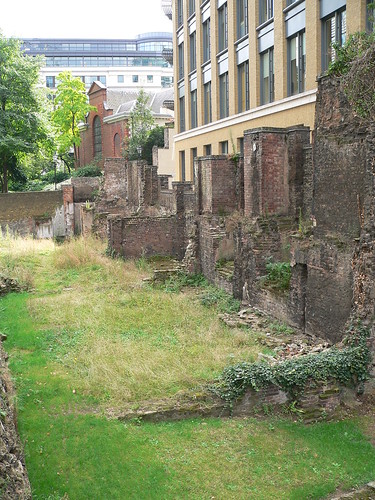
20. At the other end of the wall remains, panel 20 has also been replaced with a glass panel.
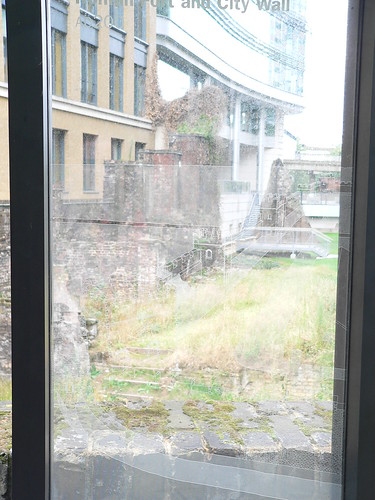
20a Detour. Since you are now almost on the junction of Gresham Street, this would be a good place to walk east along Gresham Street to the Guildhall. Whilst this is a very interesting Medieval building in its own right, it may not seem obvious why this is relevant to a walk along Roman remains - but the large oblong marked out in the pavement here shows the extent of the London's Roman Amphitheatre. Its remains can be seen deep below the Guildhall Library and Gallery, and this is well worth a visit.
21. Head back to London Wall junction with Aldersgate. Panel 21 is now sited on a fairly modern building on this junction. This is not its original position.

21a. The site of Aldersgate is also marked by a City of London Blue Plaque just beyond the wall walk panel.

22. Cross the road here, following Aldersgate Street, turn right at the end and head to Newgate street. Wall remains are visible in the basement of one of the Merrill Lynch buildings here roughly behind the Cafe Nero, and can be viewed by appointment with security. I had a meeting here and saw the nicely preserved remains of a tower but unfortunatly I didn't have a camera with me.

23. Follow Newgate street to the junction of Old Bailey - this is the original site of the New Gate which was used as a jail before giving its name to the much larger prison that replaced it. The Central Criminal Court now stands here - and has some wall remains in its basements, but these are not open to the public.
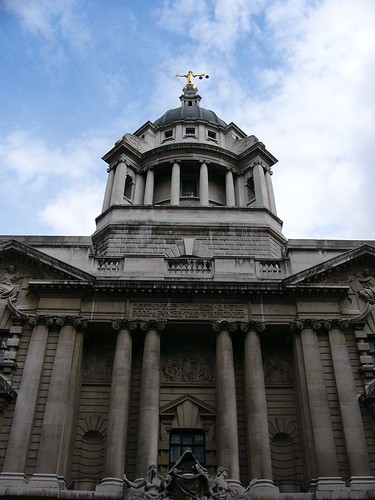
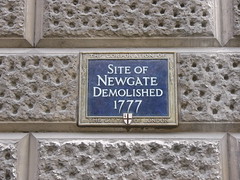
24. Follow Old Bailey to the junction of Ludgate hill, turn left. The site of the Ludgate is marked on the side of St Martin within Ludgate.
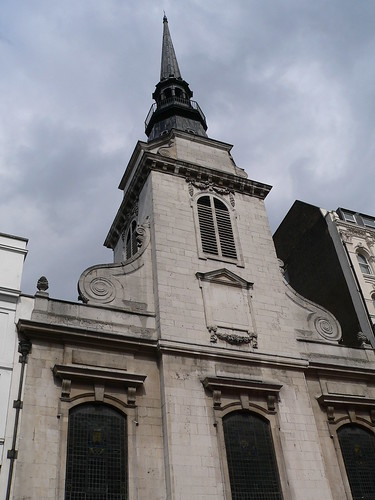
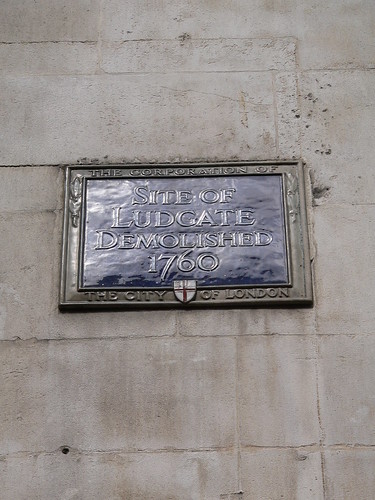
24a. Detour. Follow Ludgate hill up to St Paul's Cathedral. on the left, now forming the gateway into Paternoster Square you will find the Temple Bar. This was designed by Wren after the great fire to be the gateway into the City of London from Westminster. By now the city was much larger, and this gateway was situated between Fleet Street and the Aldwych. Its original position is now marked by a large Dragon on a pillar. This gateway was bought by a Brewer and was moved to be the Gateway to his country mansion, but was returned to the City just a few years ago.
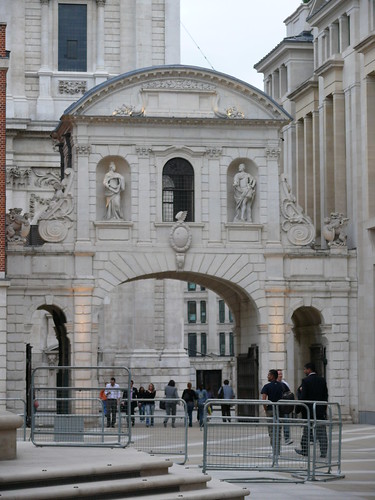
25. The Roman wall went from Ludgate directly south until it met the river, but its course was changed to run west until it met the river Fleet and then south along the Fleet until it met the Thames, to enclose the priory that this area 'Blackfriars' is still named after. Follow Pilgrim Street opposite St Martins. This follows the line of the Medieval wall, and the position of the wall is marked in the pavement at the back of the modern City Thameslink Station.
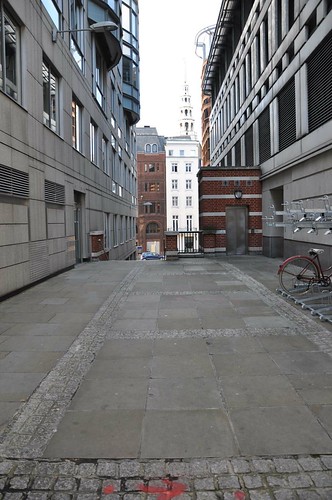
25a. The line of New Bridge Street marks the position of the Fleet River (which runs below the street in a victorian sewer) and also marks the line of the wall. Follow new Bridge Street to the Thames.
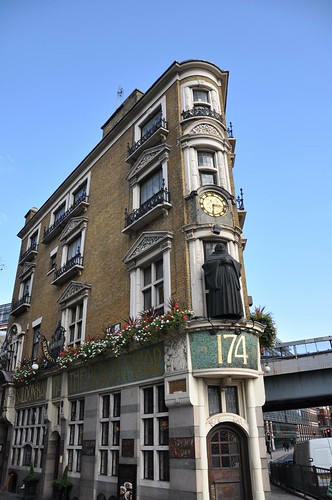
26. Walk along the riverside as far as the Cannon Street railway bridge, then turn up Cousin Lane. The Roman wall here was a short distance inland, with wharves along the riverside. The railway bridge markes the approximate position of the Dowgate - this road is still called Dowgate hill.

27. Walk along Lower Thames Street. This road marks the approximate position of the wall. Just beyond the current London Bridge you'll find St Magnus the Martyr church. The walkway through the tower was once the entranceway onto the pedestrian part of Old London Bridge. If the church is open, its worth a look, and contains a huge model of old london bridge.
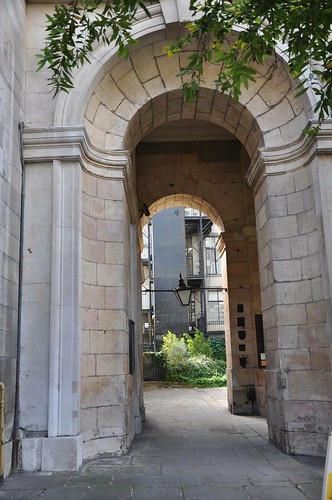
28. Continue along Lower Thames street to Old Billingsgate Market, which commemorates the last gateway into the city of London, and the centre of the frontage of the old building even retains the look of a gateway.
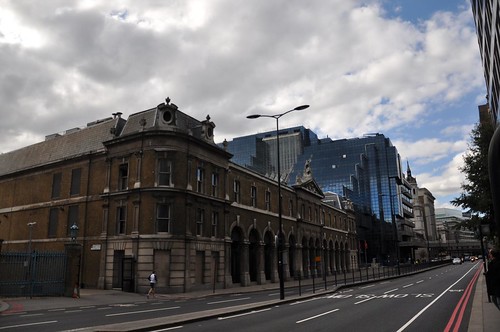
28a Opposite the old Billingsgate market building is a unassuming 1960's office building at 101 Lower Thames street. It's not currently open to the public except on special occasions, but in the basement are the remains of Roman bath house and villa.
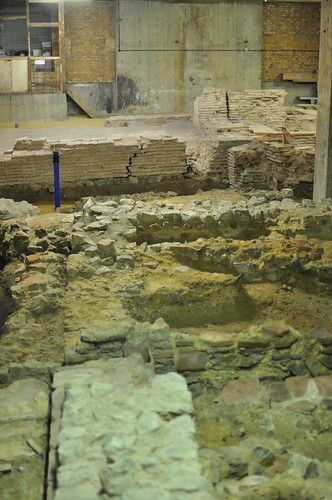
28b Another Detour. As you walk the last short distance from Billingsgate to the Tower, stop as All Hallows by the Tower church. It claims to be the oldest church in London, and has a Saxon Arch. Take a look at the free exhibition in the crypt, as here you can see some original Roman Pavement.
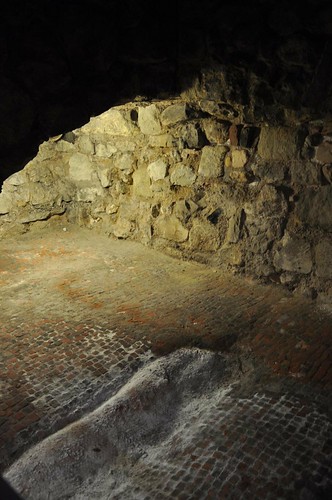
29. Return to the Tower of London. Although its quite expensive to visit the Tower, inside there are a number of large parts of the Roman wall still visible. And, of course, the Tower is well worth a visit in its own right.
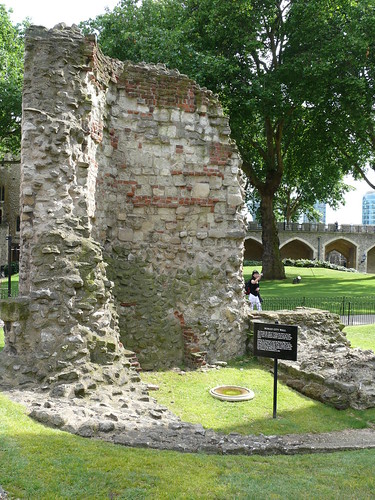

The Museum of London planned a Wall walk in the 1980's, but as the intention was to guide tourists to the museum itself, this only went from the Tower of London to the museum building - about half the length of the Wall (if you include the riverside section). This was marked with 21 numbered blue and white tile information panels - plus an introduction at each end of the walk; about half of which still exist. Some are in remarkably good condition, some have been replaced, others are just missing. The fate of some echo the recent history of london - for example panel 8 was destroyed by an IRA bomb.
So this post is a description of a walk around the entire route of the walls, with some Roman themed detours, and a few of my pictures. We start and end at The Tower of London - allow at least 2 and a half hours without the detours.
1. From Tower Hill tube, take the steps down under the underpass. The interesting remains here are not Roman, but are of a medieval pedestrian gateway through the Wall - a postern. The information panel is on the wall, but this is not Panel 1, that is no longer here - I suspect the modern steel panels on the handrail around the excavations have replaced the original tile one.



2. Go back though the underpass, turn right halfway up the steps. The wall remains here are some of the largest remaining, and the Roman section can be seen - obvious because of the red tile sections. Panel 2 is on the modern wall to the left. The statue here is said to be of the emperor Trajan.



3. Go back to the tube station, turn left and follow the road. Look at the brass plaque on the hotel front, which has some interesting information about the Wall.

3a. Go through the hotel driveway to the large section of visible wall. This is the original location of Panel 3, which has been replaced by this Brass one. Follow the walkway here that goes through a hole in the wall, then through the courtyard to the road beyond. Turn left, under the railway arch and walk through America Square.



3b. Number One America Square now has a conference centre in its basement, which has a large section of preserved wall running right through it as a feature. I haven't been in personally, but their website shows some nice views of the wall remains. At the other side of this building, look over the low wall, where a portion of wall in the basement is visible through glass panels. You can use the parish boundary marker on the building opposite as a rough guide to where the wall ran.

4. Return to Vine street, and continue north. The original wall walk map shows panel number 4 to be in the next courtyard on the left hand side of the road. Either the panel has gone, or the area its in is no longer open to the public. From here turn take the next left, then right towards Aldgate.
There is other evidence of the wall here, notice the building names such as Roman Wall House.
5. At the large intersection that is now Aldgate, you will find panel 5 on the low wall to the Sir John Cass' school playground.

5a. I'm not sure how long this will be here, but just at the moment there is an artwork here, that is apparently a representation of the rooms over the Gateway of the Aldgate.

6. Go down into the subway entrance to the right. There are some interesting tiled information planels in the subway, including Panel number 6. Where the subway excavations crossed the line of the wall are now some large tile cutaways of the wall - but at the time of writing, this subway is closed to the public, which is a shame, as I found plaque 6 to be particularly well preserved. Head back up to ground level, and follow Duke's Place and then Bevis Marks towards the City.

7. Bevis Marks would have been the route of the road inside the city walls, with the parallel Houndsditch literally being the ditch outside the city walls. You will find Panel 7 halfway along Bevis Marks, on the left hand side, under a collonade, right next to the entrance of the London Synagogue.

8. Follow Bevis Marks until it becomes Camomile Street and then emerges onto the large junction with Bishopsgate and Wormwood Street. Plaque 8 was at this junction but was destroyed by an IRA Bomb in 1993. The actual site of the Bishops Gate here was marked on both sides of the street by stone bishops mitres set into the walls of the buildings. The one in the picture below has now gone - as this building has been replaced by the Heron Tower. I'll be interested to see if this new building gets any sign once its complete. (At the time of writing, the one facing it is still there).


9. Turn right into Bishopsgate, and then immediatly left into the path though the churchyard. The backs of the buildings on the left are all quite modern, but still follow the line of the wall. Panel 9 was here somewhere, but I've not yet been able to find any trace of it. In most places where Panels are missing, there is usually still a bracket or post. In places like this, where there is nothing I can't be sure I'm looking in exactly the right place...

10. At the end of the path, turn left and then right onto the road called London Wall. After a short distance you will come to All Hallows on the Wall, whose north edge is built exactly on the london wall. There is a chapel here that follows the line of an original roman tower on the wall - just visible in the second picture below. I have yet to see this for myself, as I have never seen the church open. The wall is prominent here in the churchyard, but Panel 10 has gone. I suspect that the 2 iron poles with the angled tops visible in the first picture originally held it.


10a Walk along London Wall towards Moorgate. After you've passed the entrance to Finsbury Circus, note that the area to the right was the site of the second St Mary of Bethlehem Hospital or Bedlam, as it became know. The institution was not here for very long (only 150 years), as the building suffered from subsidence - hardly surprising as it was built on the ditch outside the city wall.

11. Panel 11 can be found on the north east corner of London Wall and Moorgate. The Moor Gate itself was not an original Roman gate in the wall - they had no need of one here as the land outside the wall was marsh. In Medeival times the marsh was drained (and filled with bones from St Peters charnel house) and this gate was added.

11a. Stay on the north side of London wall here, and get up onto the Barbican highwalks. London Wall the road here diverges from the line of the wall itself. the remains of St Alphages church can be seen here, but note that the remianing part of the church is some distance from the wall.

12. There are large sections of wall visible in St Alphages gardens, and this is now the north wall of the Roman fort that was constructed before the walls. There are three seperate gardens here - on the North side the Salters Hall have very smart gardens.

12a. On the South side is a long and narrow public garden with this old Plaque on the wall.

12b. At the Western end of this is another public garden, much like the Salters one, and here, between two planters is the remains of two stumps, which I assume are the original location for Panel 12.

13. Panel 13 is just a little to the west of the gardens on the side of Roman House, and marks the location of the Cripple Gate.



14. From here, walk into the Barbican compex at ground level, around St Giles Cripplegate church. There are many remains of the wall here, including the bases of some of the towers. Panel 14 is on the handrail in the churchyard.


15. Finding Panel 15 takes a little effort. Retrace your steps to the site of Cripplegate, then continue along Wood Street to junction of London Wall. Turn right and follow London Wall until you reach the entrance to the underground car park. Go into the Museum gardens here and follow the line of the wall as far as you can into the Barbican. Panel 15 is on your right.


16. Retrace your steps again along the route of remains. The Barber Surgeons (whose modern hall is here) used to have their hall right against the wall - and even used one of the towers as a court. This Tower has now been turned into a small herb garden - and as far as I can work out, this was the location of panel 16.

Its interesting to note that the shape of the new hall echos the Wall tower.

17. Panel 17 is also missing, but would originally have been on the other side of the remains in the picture below. The white building in the picture is the Museum of London, and a window looks down on the wall remains from the Roman Gallery.

18. Panel 18 survives at the bottom of the ramp next to the entrance to the car park.

18a. There are remains of a gate under the road behind a door marked private that can be seen on tours run by the museum. Look out on the meseum website for Tours of the Roman Fort. I got on one in August and found it very interesting.


18a Detour. This is the best place to detour into the Museum of London. There are lots of great Roman (and other) stuff in here.
19. Opposite the museum take Nobel Street next to the large wall remains visible here. Panel 19 has been replaced by a glass panel.

20. At the other end of the wall remains, panel 20 has also been replaced with a glass panel.

20a Detour. Since you are now almost on the junction of Gresham Street, this would be a good place to walk east along Gresham Street to the Guildhall. Whilst this is a very interesting Medieval building in its own right, it may not seem obvious why this is relevant to a walk along Roman remains - but the large oblong marked out in the pavement here shows the extent of the London's Roman Amphitheatre. Its remains can be seen deep below the Guildhall Library and Gallery, and this is well worth a visit.
21. Head back to London Wall junction with Aldersgate. Panel 21 is now sited on a fairly modern building on this junction. This is not its original position.

21a. The site of Aldersgate is also marked by a City of London Blue Plaque just beyond the wall walk panel.

22. Cross the road here, following Aldersgate Street, turn right at the end and head to Newgate street. Wall remains are visible in the basement of one of the Merrill Lynch buildings here roughly behind the Cafe Nero, and can be viewed by appointment with security. I had a meeting here and saw the nicely preserved remains of a tower but unfortunatly I didn't have a camera with me.

23. Follow Newgate street to the junction of Old Bailey - this is the original site of the New Gate which was used as a jail before giving its name to the much larger prison that replaced it. The Central Criminal Court now stands here - and has some wall remains in its basements, but these are not open to the public.


24. Follow Old Bailey to the junction of Ludgate hill, turn left. The site of the Ludgate is marked on the side of St Martin within Ludgate.


24a. Detour. Follow Ludgate hill up to St Paul's Cathedral. on the left, now forming the gateway into Paternoster Square you will find the Temple Bar. This was designed by Wren after the great fire to be the gateway into the City of London from Westminster. By now the city was much larger, and this gateway was situated between Fleet Street and the Aldwych. Its original position is now marked by a large Dragon on a pillar. This gateway was bought by a Brewer and was moved to be the Gateway to his country mansion, but was returned to the City just a few years ago.

25. The Roman wall went from Ludgate directly south until it met the river, but its course was changed to run west until it met the river Fleet and then south along the Fleet until it met the Thames, to enclose the priory that this area 'Blackfriars' is still named after. Follow Pilgrim Street opposite St Martins. This follows the line of the Medieval wall, and the position of the wall is marked in the pavement at the back of the modern City Thameslink Station.

25a. The line of New Bridge Street marks the position of the Fleet River (which runs below the street in a victorian sewer) and also marks the line of the wall. Follow new Bridge Street to the Thames.

26. Walk along the riverside as far as the Cannon Street railway bridge, then turn up Cousin Lane. The Roman wall here was a short distance inland, with wharves along the riverside. The railway bridge markes the approximate position of the Dowgate - this road is still called Dowgate hill.

27. Walk along Lower Thames Street. This road marks the approximate position of the wall. Just beyond the current London Bridge you'll find St Magnus the Martyr church. The walkway through the tower was once the entranceway onto the pedestrian part of Old London Bridge. If the church is open, its worth a look, and contains a huge model of old london bridge.

28. Continue along Lower Thames street to Old Billingsgate Market, which commemorates the last gateway into the city of London, and the centre of the frontage of the old building even retains the look of a gateway.

28a Opposite the old Billingsgate market building is a unassuming 1960's office building at 101 Lower Thames street. It's not currently open to the public except on special occasions, but in the basement are the remains of Roman bath house and villa.

28b Another Detour. As you walk the last short distance from Billingsgate to the Tower, stop as All Hallows by the Tower church. It claims to be the oldest church in London, and has a Saxon Arch. Take a look at the free exhibition in the crypt, as here you can see some original Roman Pavement.

29. Return to the Tower of London. Although its quite expensive to visit the Tower, inside there are a number of large parts of the Roman wall still visible. And, of course, the Tower is well worth a visit in its own right.

Subscribe to:
Comments (Atom)